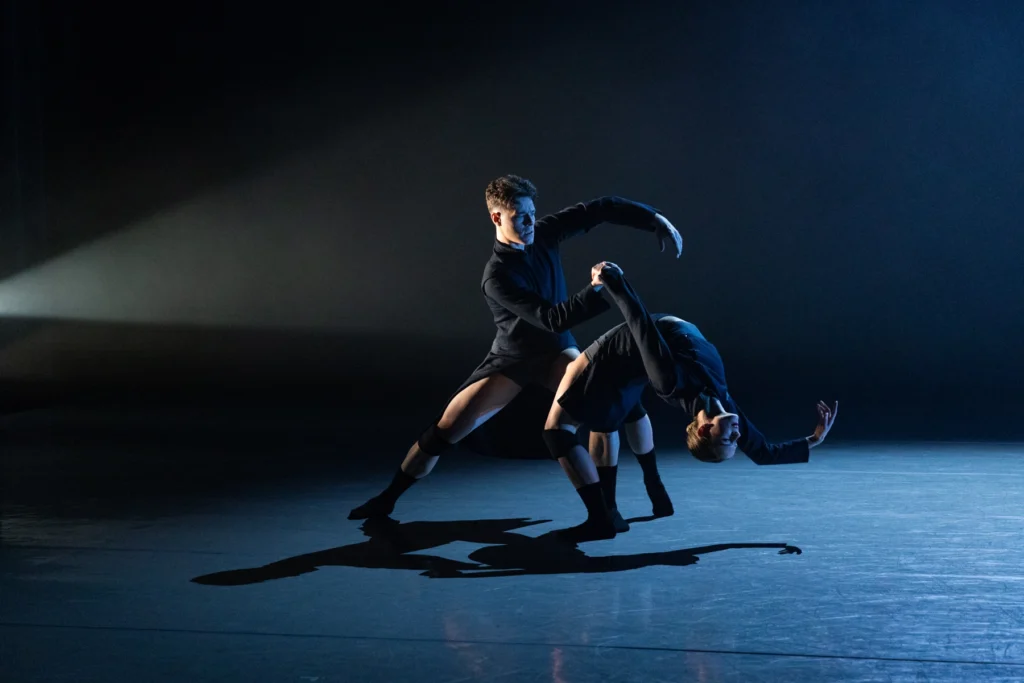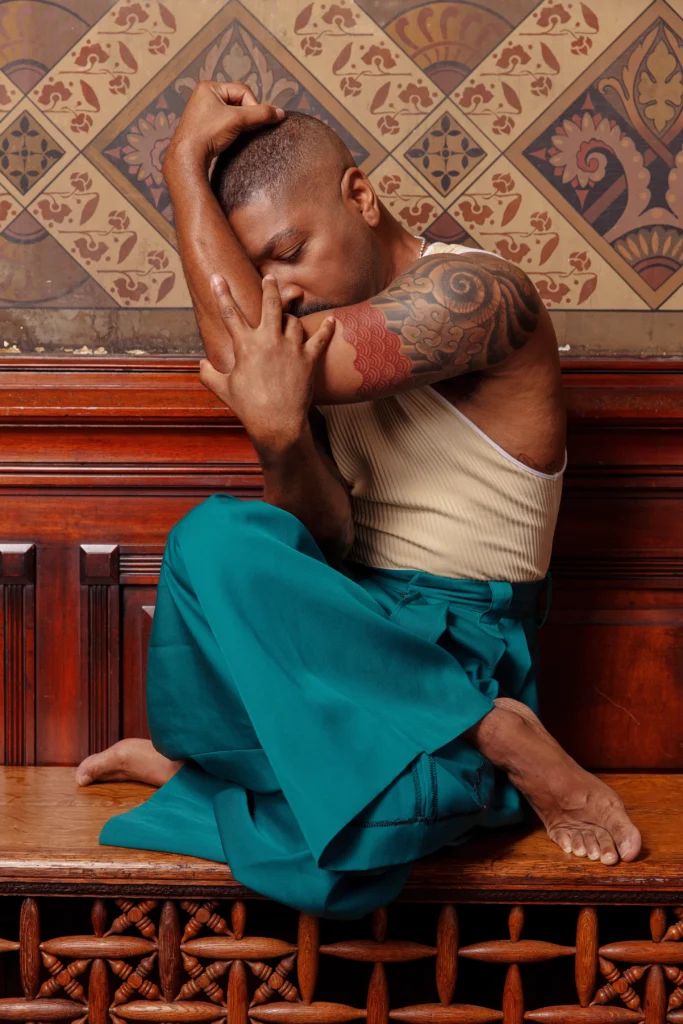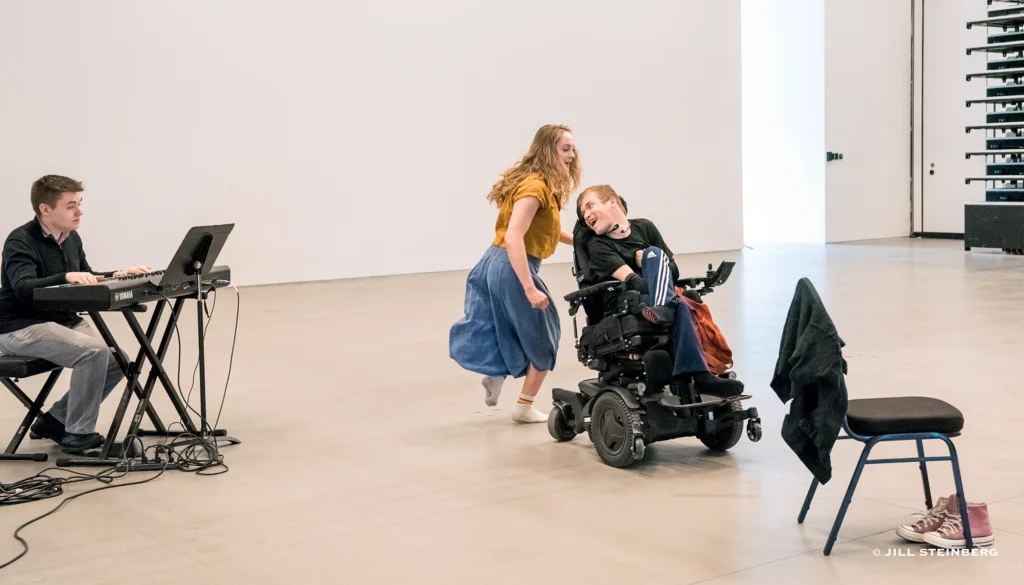Season Preview: 28 Must-See Shows in 2024–25
From major tours to noteworthy premieres to Hollywood-inspired musicals (and one movie musical), here are 28 shows on our contributors’ must-see lists.
Jennifer Archibald Gains Momentum

Jennifer Archibald is having a moment: On the heels of premieres at The Kennedy Center and Jacob’s Pillow this summer, the contemporary ballet choreographer has been commissioned by no fewer than seven ballet companies to create world premieres for this season. Those hoping to see all of her new works will need to travel to Smuin Contemporary Ballet (Sept. 13–Oct. 20), Terminus Modern Ballet Theatre (Sept. 14–22), Grand Rapids Ballet (Oct. 11–13), The Washington Ballet (Feb. 20–23), BalletX (May 2–3), National Ballet of Canada (May 30–June 5), and BalletMet (June 6–14). For bonus points, you can catch presentations of her existing repertoire at PARA.MAR Dance Theatre (Sept. 20–21), Charlotte Ballet (Oct. 4–26), and Nashville Ballet (May 2–4).
Notably, for BalletX, Archibald is creating a full-length work inspired by the novel Lord of the Flies. The piece will be brand-new, but so is the opportunity to create it. “No other Black female choreographer is getting full-length ballets,” she says. “This is hard—convincing a ballet organization to believe in your work and to believe in it on a financial level.” While this season seems like a peak she could rest on, Archibald has no intention of slowing down anytime soon. “What makes me wake up every morning is just to continue the work.” jenniferarchibald.com.
—Hannah Chang Foster
The Final Countdown

In 1947, the Doomsday Clock was created by the Bulletin of the Atomic Scientists to warn humanity of imminent destruction. Now, Blue13 Dance Company’s 100 Seconds to Midnight draws from the metaphorical clock to explore the generational effects of colonization. The piece is split into three movements: “Vishwas,” “1947,” and “Midnight.” “1947,” which premiered as a standalone work in 2022 at the USC Glorya Kaufman School of Dance, made a poignant connection between the clock and Indian independence, using a sound score that integrated audio accounts of survivors of the India–Pakistan partition that killed more than 1 million and displaced more than 10 million. 100 Seconds to Midnight expands on the themes of “1947,” using artistic director Achinta S. McDaniel’s signature blend of kathak, Bollywood, ballet, and hip hop for an evening-length work interrogating the erasure of South Asian people throughout history. Premieres at Los Angeles’ The Ford Sept. 28. blue13dance.com. —Steven Vargas
Women’s Work

“Ballet is woman,” indeed! This season promises an exciting lineup of new story ballets featuring strong female leads by woman choreographers. In Clara, premiering Oct. 11–Nov. 15 at Ballet Zurich, artistic director Cathy Marston tells the story of the 19th-century German composer Clara Schumann. Feb. 28–May 27, Reija Wäre goes modern chanson for Édith Piaf—La vie en rose at Finnish National Ballet. In keeping with Helen Pickett’s literary bent, her Lady Macbeth, for Dutch National Ballet (April 5–22), will peer into the mind of Shakespeare’s infamous Scottish villainess. Then, April 4–13, Oregon Ballet Theatre brings Hollywood’s favorite blonde bombshell to life in Marilyn, artistic director Dani Rowe’s first full-length ballet, a co-production with BalletMet and Tulsa Ballet. And while the past year has boasted no shortage of Carmen adaptations, Annabelle Lopez Ochoa’s and Andrea Schermoly’s new evening-length interpretations particularly rouse interest. They will premiere at Miami City Ballet April 25–May 4 and at Charlotte Ballet May 2–11, respectively. opernhaus.ch, oopperabaletti.fi, operaballet.nl, obt.org, miamicityballet.org, and charlotteballet.org.
—Kyra Laubacher
Death Becomes Broadway

It can be hard to get excited about yet another movie-turned-musical. But the 1992 cult film Death Becomes Her, coming to Broadway in musical form this fall, seems fabulously well-suited to the stage. A biting commentary on our obsession with eternal youth, it’s a work of high camp and broad physical comedy, two languages that Broadway speaks particularly well—and that dance can elevate to sublime levels.
Director and choreographer Christopher Gattelli is fluent in all these tongues. His spin on Death Becomes Her is maximalist and always in on the joke, full of irreverent-yet-affectionate dance satire. (Choruses of dancing “immortals” in slinky black unitards, for example, feel straight out of the Fosse playbook.) And he’s helped by a phenomenal principal cast that includes capital-D divas Megan Hilty, Jennifer Simard, and Michelle Williams (of Destiny’s Child fame). Dancers they’re not, but immortals? They just might be. Begins previews Oct. 23 ahead of a Nov. 21 opening at the Lunt-Fontanne Theatre. deathbecomesher.com. —Margaret Fuhrer
Louisville Proud

Ching Ching Wong’s latest work for Louisville Ballet is a celebration of the city’s creativity and spirit, says the Filipino-born choreographer. Titled after Louisville’s area code and danced to music by city native Jack Harlow, 502 swirls together onstage dirt, mirror balls, pointe shoes, and a cast of 40 dancers. “The mirror balls are manufactured locally and symbolize how we cast our light as far and wide as possible,” says Wong, “yet a part of us always returns home to the soil from which we come.” The premiere’s hometown eclecticism will be paired with co-artistic director Harald Uwe Kern’s new ballet for the company, Influences, set to music by Robert Schumann, and a new work by resident choreographer Adam Hougland on the Triple Take program. Louisville’s Brown Theatre, Nov. 1–3. louisvilleballet.org. —Steve Sucato
Camille Takes On a Classic

Camille A. Brown’s Broadway shows have run the gamut—plays by Tennessee Williams and Ntozake Shange, musicals set in the Caribbean (Once on This Island) and in Manhattan (Hell’s Kitchen)—and they’ve earned her four Tony nominations along the way. With Gypsy, she gets her first crack at a classic Broadway musical—some would say the classic Broadway musical, with a book by Arthur Laurents, music by Jule Styne, and lyrics by Stephen Sondheim. And with its front-facing vaudeville parodies and strip numbers, it presents her with new ways to dig into America’s vernacular dance languages.
For the indomitable stage mother at the center of the story, it’s Audra’s turn—the six-time Tony winner Audra McDonald gets to have a nervous breakdown eight times a week in the climactic “Rose’s Turn,” and we get to see what director George C. Wolfe makes of the 1959 musical that garnered eight Tony nominations and won none (it was The Sound of Music’s year). Previews begin Nov. 21 at the Majestic Theatre, with an opening set for Dec. 19. gypsybway.com.
—Sylviane Gold
The Wicked Film (Finally) Takes Flight

After years of delays, the first installment of the two-part film adaptation of Broadway’s Wicked arrives in movie theaters Nov. 22. The furious excitement of the show’s devoted fan base, only heightened by all that waiting, means the movie is probably gonna be popular. But will its dancing change us for good?
Trailers haven’t revealed much about Wicked’s choreography, by Christopher Scott and Will Loftis. (Wayne Cilento, who choreographed the stage musical, also gets a nod in the credits.) But we know that director Jon M. Chu—who helmed multiple Step Up movies, and whose 2021 film version of In the Heights comes to most vibrant life in its dance scenes—loves and understands dance. We know that Scott, a longtime Chu collaborator who helped create those kaleidoscopic In the Heights dance parties, can do dazzling large-scale spectacle, Wicked’s stock in trade. And we know that Loftis has sparkly chemistry with the film’s Glinda, Ariana Grande: She asked him to choreograph her recent “Yes, And?” music video.
All that might add up to Wicked dancing that defies gravity. We’ll find out this fall. wickedmovie.com. —Margaret Fuhrer
Extending Empathy

Combining the groove of hip hop, the gutsiness of modern dance, and the expansive lines of ballet, Kyle Abraham has been spinning his own inimitable movement vocabulary for two decades. Even more compelling is the tingling of vulnerability that infuses his choreography. To close out the year, the massive Park Avenue Armory in New York City presents the premiere of Abraham’s Dear Lord, Make Me Beautiful, which explores themes of empathy and humanity in a chaotic world, and in which Abraham himself will be performing. He brings his dancers together with the avant-garde musicians of yMusic and a techno-inspired visual set by Cao Yuxi (JAMES) for what promises to be a large-scale yet intimate, tender work. Dec. 3–14. armoryonpark.org.
—Wendy Perron
Twyla Coast to Coast

Her Diamond Jubilee—celebrating 60 years of dancemaking—finds Twyla Tharp on tour with two supremely musical works. She’s reviving her 1998 Diabelli, a piece set to Beethoven’s Diabelli Variations. And she’s creating a new work in collaboration with the Grammy-winning quartet Third Coast Percussion, which is devising a score inspired by Philip Glass’ Aguas da Amazonia that it will play live at select engagements—a promising pairing, given that Tharp’s last use of Glass’ music gave us the exhilarating In the Upper Room. The tour kicks off Jan. 26 at Northrop in Minneapolis and threads its way through Detroit (Feb. 1–2), Berkeley (Feb. 7–9), Santa Barbara (Feb. 11), San Diego (Feb. 13), Costa Mesa (Feb. 15–16), Palm Desert (Feb. 18), Northridge (Feb. 22–23), Santa Fe (Feb. 25–26), Sarasota (March 4), Tallahassee (March 6), Cleveland (March 8), New York City (March 12–16), Washington, DC (March 26–29), Richmond (April 5), Chicago (April 10 and 12), Madison (April 15), Princeton (April 17), and Pittsburgh (April 19), with more dates and locations in the wings. —Wendy Perron
Queering Mythology

A night at the club can be divine, with a master deejay energizing the dance floor, everyone there embodying the music to tell their story. In Pioneer Winter’s DJ Apollo, divinity indeed enters that scene as a young queer dancer interacts with three of his community’s elders—avatars of the Greek god, guardian of the arts, now a vehicle of legacy and continuity. Amid a swirl of memories and intergenerational give-and-take, they uphold an authentic identity. “A mark of queer people is to reinvent themselves,” says Winter. “This is about self-birthing through past lives.” Voices and visuals will reference Balanchine’s Apollo, autobiographical testimony from the performers, and gay anthems—the soundscape by Juraj Kojš also embracing Stravinsky. The evening-length work premieres at Miami Theater Center in April. pioneerwinter.com. —Guillermo Perez
It’s Gonna Be a Smash

After years of rumors and false starts, the guilty pleasure that was NBC’s “Smash” is finally coming to Broadway—which is where its head was all along. A steamy backstage drama centered on the creation of a Marilyn Monroe musical called Bombshell, the 2012 series brought together a slew of theater, television, and film talents that was catnip for theater cats, but didn’t draw enough of an audience to last beyond its second season. The Broadway version is going all in on the theater side—Tony winners Marc Shaiman and Scott Wittman (Hairspray) are adding new songs to the ones they wrote for the series, and Tony nominee Joshua Bergasse (On the Town) returns to choreograph. Joining the project are Bob Martin (The Drowsy Chaperone) and Rick Elice (Jersey Boys), to do the book, and the great Susan Stroman, to direct. Robyn Hurder, who earned a 2023 Chita Rivera Award for her knockout performance in A Beautiful Noise and a Tony nomination for Moulin Rouge!, will be donning the blonde Marilyn wig sometime this spring. smashbroadway.com. —Sylviane Gold
A Dystopian New Opera, AI Included

The central character of Sensorium Ex, an experimental new opera created by composer Paola Prestini and librettist/poet Brenda Shaughnessy, is Kitsune, a nonverbal, nonambulatory child. To thwart the story’s villain—a corporate overlord set on replacing humans with robots—Kitsune must find a way to express himself, his wants, and his needs. One way he’ll do that: movement. Jerron Herman, whose multidisciplinary dances often explore the intersection of disability and technology, is well-suited to the job of choreographing—and co-directing, with Jay Scheib—the opera, which asks who can have a voice and what it means to speak without language.
In addition to the opera itself, Sensorium Ex will include an interactive installation that will gather data to inform the character of Sophia (an AI robot and the opera’s narrator) and to create an application aimed at democratizing synthetic voice technology for people with disabilities. Premieres at the Common Senses Festival in Omaha, NE, May 22–25, with tour dates to be announced. visionintoart.org. —Lauren Wingenroth
Get Thee to a Theater
Two South African choreographers reexamine Shakespeare through the lens of their home country.
Mthuthuzeli November’s Fools

South African choreographer Mthuthuzeli November is no stranger to creating narrative ballets. From delving into the experiences of Black miners and their families in his Olivier Award–winning Ingoma (2019) to spotlighting the legendary singer and civil rights activist Nina Simone in Nina: By Whatever Means (2023), he has consistently pushed the boundaries of whose stories are told in ballet.
This year, November’s set to tackle his first Shakespeare with Fools: A Romeo & Juliet inspired story, a new creation for Northern Ballet. True to form, he’ll be putting a new spin on one of the world’s most well known stories: He is referencing not only the Bard’s text but also Xhosa South African writer R.L. Peteni’s 1976 novel Hill of Fools, to tell a tale of rivalry between two villages through ballet—and, knowing November, probably some other movement styles, as well. Premieres as part of Northern Ballet’s Three Short Ballets program, alongside a new work by Kristen McNally and Rudi van Dantzig’s Four Last Songs, at Leeds Stanley & Audrey Burton Theatre, Sept. 6–14. The triple bill will also be performed in London at the Royal Opera House’s Linbury Theatre Jan. 28–31. northernballet.com. —Emily May
Dada Masilo’s Hamlet

Internationally lauded South African artist Dada Masilo is known for reimagining classic works, among them Giselle and The Rite of Spring (sans Stravinsky). In her latest, Hamlet, which has its U.S. premiere this fall, she interprets the Shakespearean tragedy from a female perspective, aiming, she says, “to make the story make sense.”
Transplanting Shakespeare’s verbose machinations of murder and betrayal to urban South Africa, she weaves 65 minutes of dance theater via an eclectic movement vocabulary, live music, and a cast that features Masilo as the ill-fated Ophelia and Bessie Award–winner Albert Khoza as Gertrude. “I’m not trying to be clever or abstract,” Masilo says. “The play is already complicated enough.” New York City’s Joyce Theater, Oct. 15–20; Pittsburgh’s Byham Theater, Oct. 23. joyce.org and trustarts.org. —Karen Dacko
Edit note: The U.S. appearances of Dada Masilo’s Hamlet have been postponed.




